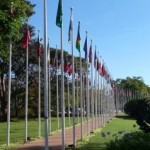
Ulaanbaatar / Bangkok – According to the “Urban Water Vulnerability to Climate Change in Mongolia” report, extreme temperatures and natural disasters such as droughts, flooding and heavy snowfalls are becoming more frequent and annual average temperatures have increased by 2.1°Celsius since the 1940s.
According to the report, the Mongolian climate will continue to change dramatically over the next century. Study results are emerging on the likely pattern of this future climate and projections suggest higher temperatures all year round, with more snow in winter and less rain in summer.
“Mongolia’s temperature has already risen by more than 2°C in the last seventy years. The study’s climate scenarios suggest that the country will have to get used to having much less water in the future,” says Dr. Z. Batbayr, Deputy Director of Mongolia Water Authority. “The impact of this will be seen across the board, through the degradation of the natural environment, ecosystems, and harm to the economy.”
All surface water in Mongolia is covered by ice for about six months a year and so groundwater is the primary source of water supply for major urban and industrial centres and the extensive animal husbandry sector. It is expected that climate change will affect groundwater resources throughout the country.
The effects of climate change have been compounded by rapid urbanization, reducing the availability of water for domestic and industrial use.
The situation is particularly serious in urban areas like the capital of Ulaanbaatar, where nearly 40 percent of the country’s population resides and where increasing demand and pollution is exerting added pressure on water supplies, sanitation and other public services, adds the report.
Globally, Mongolia is one of sixty countries with limited water resources. The country’s total water consumption is approximately 540 million m3 per year and over 80 percent is consumed by the industrial and agricultural sectors and 20 percent goes to domestic use. There is over 11,000 m3 of water per year for each of the country’s 2.4 million people.
“If the status quo for water management in Mongolia continues, the country will not be able to provide sustainable water resources for its population under future climate change,” says Dr. Young-Woo Park, UNEP Regional Representative for Asia and the Pacific. “Steps need to be taken now so that Mongolia adapts to its changing environment, and I am glad that the Government has plans to act based on the findings of the report.”
In Ulaanbaatar, 50 percent of the one million population live in informal settlements (Ger areas) with a low-level of public services. The daily water consumption is only about 5-10 litres per capita per day, and very few are connected to the city’s water distribution network.
Currently, water is being withdrawn faster than the rate of discharge in the city, where groundwater tables have shown a marked decline in the past 50 years. A large part of the water resources for the city comes from the Tuul River, where continuing ecosystem degradation will prove extremely costly in terms of water and other services lost, the report says.
Overall, improved conservation of the Upper Tuul ecosystem is estimated by the report to be worth some US $ 979 million through the provision of water, tourism, herding, and forest products.
The report makes following key adaptation recommendations for Mongolia:
- Develop an Integrated Urban Water Management plan for the Tuul River Basin, with active planning and management of land use and human activities;
- Increase investment and rehabilitate existing water supply networks for the domestic water supply. This should include raising public awareness about saving water, building water recycling plants, and improving the management of water supply utilities;
- Take steps to reduce the population’s vulnerability to extreme weather events, such as improving existing flood protection systems, install an early warning system, review housing and settlement plans, and raise public awareness about extreme weather events; and
- Do more to improve water quality, particularly through the rehabilitation of wastewater treatment plants, especially in Ulaanbaatar and have better enforcement of the legal framework on water supply, disposal and wastewater treatment. This should include the introduction of practices to reuse and recycle wastewater.
The report was launched on World Water Day 2011, when the focus is on sustainable development in the run-up to RIO+20 meeting, trans-boundary waters, sanitation and coping with water scarcity.
Notes:
About the Report
The “Urban Water Vulnerability to Climate Change in Mongolia” was produced by Mongolia Water Authority with the support of the United Nations Environment Programme. It is a joint collaborative effort of the Water Authority of the Mongolian Ministry of Nature and the non-governmental organisation, “Arvian Khelkhee”.
In recent years, the exploration for natural resources has also increased rapidly and many rivers, or parts of the rivers, are polluted by industrial and mining activities. ?any river basins are under intensive use due to mining for gold, silver, coal, precious stones, gravel, and other natural resources.
Gold mining affects the quality of 28 rivers in eight provinces of Mongolia. In particular, the upper stream of the Orkhon River, downstream reaches of the Tuul River, and the Eroo River in the Selenge River basin. Also the Orkhon, Tuul, Kharaa and Khangal river basins are experiencing increasing pollution as a result of urbanization and industrial activities within the basin.
The rivers in Mongolia are of mountainous origin and their major source of water is rainfall. Mongolia has around 4,100 rivers with a total length of 67,000 kilometers. About 60 percent of the river-runoff formed in the Mongolian territory drains into Russia and China.















[…] what created the conditions for this occur? According to one report, Mongolia’s temperature has risen 2 degrees Celsius over the last 70 years, leading to […]